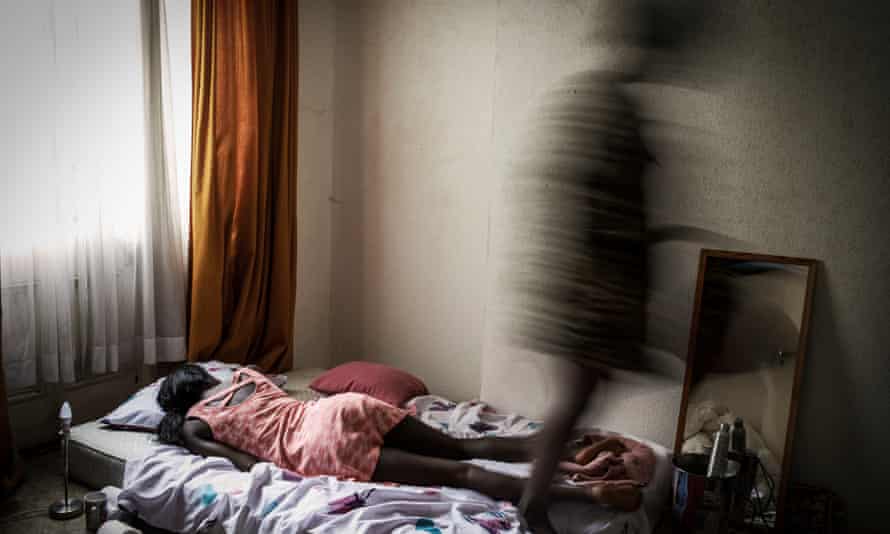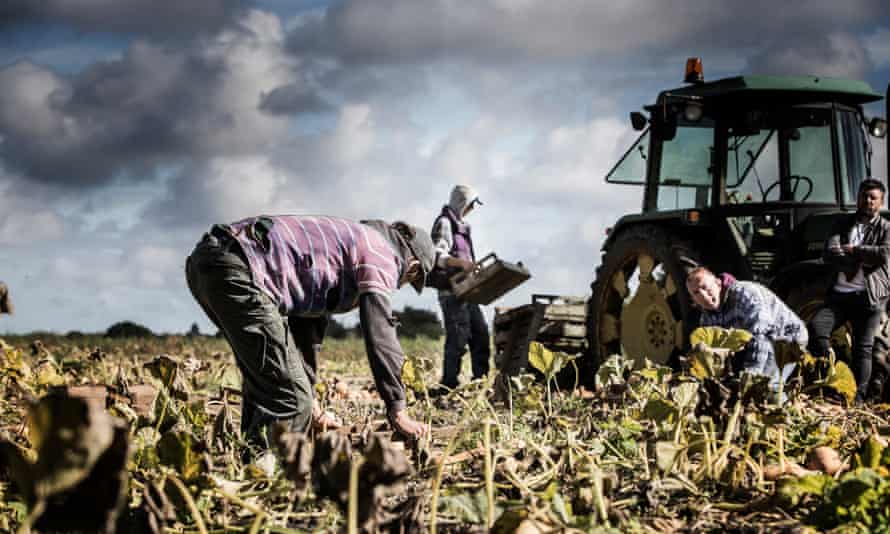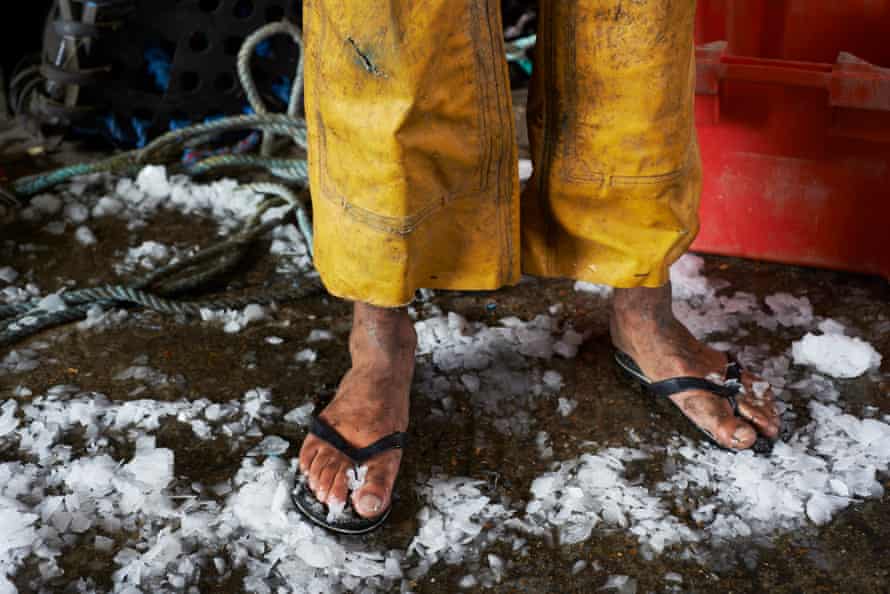As Slaves Begin Forming Extended Families, What Became the Center of Family Life?
How many slaves are there today, and who are they?
The give-and-take "slavery" conjures upwards images of shackles and transatlantic ships – depictions that seem relegated firmly to the by. But more people are enslaved today than at whatever other time in history. Experts have calculated that roughly xiii meg people were captured and sold every bit slaves between the 15th and 19th centuries; today, an estimated 40.3 million people – more than three times the effigy during the transatlantic slave trade – are living in some form of modern slavery, according to the latest figures published by the UN'south International Labour Arrangement (ILO) and the Walk Free Foundation.
Women and girls comprise 71% of all modern slavery victims. Children make up 25% and account for x one thousand thousand of all the slaves worldwide.
What are the slaves being forced to do?
A person today is considered enslaved if they are forced to work confronting their will; are endemic or controlled by an exploiter or "employer"; have limited freedom of movement; or are dehumanised, treated every bit a commodity or bought and sold every bit property, according to abolitionist group Anti-Slavery International.
Globally, more than half of the twoscore.three million victims (24.9 million) are in forced labour, which means they are working confronting their will and under threat, intimidation or compulsion. An additional 15.4 one thousand thousand people are estimated to be living in forced marriages.

Of the 24.nine million people trapped in forced labour, the bulk (16 million) work in the private sector. Slaves make clean houses and flats; produce the clothes we wearable; selection the fruit and vegetables we eat; trawl the seas for the shrimp on our restaurant plates; dig for the minerals used in our smartphones, makeup and electric cars; and work on construction jobs building infrastructure for the 2022 Qatar World Cup.
Another 4.8 1000000 people working in forced labour are estimated to be sexually exploited, while roughly 4.1 million people are in state-sanctioned forced labour, which includes governmental abuse of military conscription and forced construction or agricultural piece of work. In certain countries such every bit Mauritania, people are born into "hereditary" slavery if their mother was a slave.
Again, women and girls bear the brunt of these statistics, comprising 99% of all victims in the commercial sex industry, and 58% in other sectors, according to the ILO.
Where is this happening?
Statistically, modern slavery is most prevalent in Africa, followed by Asia and the Pacific, according to the Global Slavery Alphabetize, which publishes land-by-country rankings on mod slavery figures and government responses to tackle the issues.
Merely the ILO and Walk Free warn that these figures are likely skewed due to lack of data from fundamental regions. "We believe that the global estimate of 40.3 million is the most reliable data to engagement, although we believe it to be a conservative gauge as at that place were millions of people we couldn't reach in disharmonize zones or on the refugee trail and places where we couldn't exist sure of collecting robust information such every bit the Gulf states, where access and language barriers prevented u.s.a. from reaching the migrant worker communities," said Michaëlle de Cock, a senior statistician at the ILO.
More than 70% of the 4.8 million sex exploitation victims are in the Asia and Pacific region. Forced marriage is most prevalent in Africa. Only there isn't a unmarried land that isn't tainted by slavery: i.5 million victims are living in developed countries, with an estimated xiii,000 enslaved here in the UK.
Why are in that location so many slaves today?
Slavery is big business organization. Globally, slavery generates as much as $150bn (£116bn) in profits every yr, more than than 1 tertiary of which ($46.9bn) is generated in developed countries, including the Eu. Whereas slave traders ii centuries ago were forced to contend with costly journeys and loftier mortality rates, modernistic exploiters have lower overheads thanks to huge advances in technology and transportation. Modern migration flows also mean that a large supply of vulnerable, exploitable people can be tapped into for global supply bondage in the agriculture, beauty, fashion and sex industries.
According to slavery skillful Siddharth Kara, modern slave traders at present earn upwardly to 30 times more their 18th and 19th century counterparts would have done. The one-off cost of a slave today is $450, Kara estimates. A forced labourer generates roughly $8,000 in annual profit for their exploiter, while sexual practice traffickers earn an average of $36,000 per victim.

"It turns out that slavery today is more than profitable than I could have imagined," Kara said. "Profits on a per-slave footing tin can range from a few thousand dollars to a few hundred thousand dollars a yr, with full almanac slavery profits estimated to be as high as $150bn."
It's important to acknowledge that global population rates also touch on estimates: the top ten countries with the highest estimated absolute number of victims are also some of the well-nigh populous. Together, these 10 countries – People's republic of china, Autonomous Congo-brazzaville, India, Indonesia, Iran, Nigeria, North korea, Pakistan, the Philippines and Russian federation – comprise 60% of all the people living in modernistic slavery, also as more than half the world's population, according to the Global Slavery Index.
An increment in violent conflict worldwide over the past xxx years has also inflated the number of people at run a risk of slavery, according to the United Nations Part on Drugs and Crime (UNODC), with armed groups and terrorists turning to trafficking "to show they have control over the customs, or to increment their force, either recruiting kid soldiers or giving sex slaves as a advantage for their recruitment".
What's the deviation betwixt slavery and human trafficking?
Homo trafficking is only one way of enslaving someone. Whereas centuries ago it was mutual for a slave trader to simply buy some other homo and "own" that person every bit their property (which does still happen), today the practice is largely more insidious.
Trafficking involves the recruitment, transfer or obtaining of an private through coercion, abduction, fraud or strength to exploit them. That exploitation can range from forced labour to forced marriage or commercial sex piece of work – and the exploiter can be anyone, including strangers, neighbours or family members. Most people are trafficked within their ain countries, although they tin as well exist trafficked abroad; most oftentimes the private is trafficked into forced labour.

Many times, the victim is led to believe they have been offered a well-paid job in a different city or land, just to find the task does not be and they are now indebted to their "employer" or trafficker and must pay transportation, lodging and any other "fees" the exploiter demands, thereby forcing the victim into debt bondage.
For instance?
Guardian investigations have revealed a slew of abuses from Qatar to Thailand, Bharat to the United States. Qatar was forced to take action later revelations of abusive practices foisted on migrant workers helping build its infrastructure for the 2022 World Cup.
Trafficking on to fishing boats is all the same widespread, particularly in south-due east and eastern asia, where men are lured by the hope of jobs in agriculture or construction, then drugged or beaten and wake up at sea.
Exploitation of migrant workers has also been revealed in Malaysia, Cambodia, China, Italy, Vietnam and the U.k..
How does someone end up condign a slave?
There is no definitive reply to this question. Mod slavery affects people of every color, age and gender – but is more than prevalent amongst vulnerable people. That might exist a Cambodian villager looking for a better paid job in a neighbouring country, only to find himself trafficked on to a angling boat.

Or a young girl forced to marry at 13 because climatic change has flooded her family'south crops and they tin can no longer afford to keep her at home. Or a homeless person kidnapped from a London soup kitchen and forced to work on a caravan site. Or a migrant whose visa has expired and can be threatened with displacement if she doesn't do what the trafficker demands.
Slavery is global but flourishes in places where the dominion of law is weak and abuse goes unchecked, says Anti-Slavery International.
Will slavery ever stop?
Activists such as Kara believe that slavery can be eradicated for adept, simply that information technology would take great political volition and considerable inquiry.
Offset, defended investigators would need to identify each level in the often murky supply chains of bolt in order to determine where labour abuses are taking identify.
Then, independent certification processes would need to be designed for each commodity, so that consumers could make educated choices about the products they are ownership and the slavery or labour abuses implicated with those purchases.
Finally, Kara says, industries would need to invest in the communities whose low-cost labour is being used to brand the products. "Doing so would help mitigate vulnerability to existence trafficked and exploited," Kara said. "Consumers may have to pay slightly more for certain goods, and multinational corporations may have to have slightly lower profits. But a freer and fairer labour environment would promote greater productivity, potentially offsetting some of those expenses."
What do I do if I recall someone is a victim of modernistic slavery?
According to Anti-Slavery International, slavery is and then common that it is possible you come up across victims "on a regular basis". Key things to look out for are whether the person has freedom of movement; appears scared, withdrawn or shows signs of abuse; has few personal belongings or identifying documents with them; or seems under the command of someone else and scared to talk.
If yous think someone may tick these boxes, it is all-time to contact government directly instead of approaching the person, as approaching them could put them in danger. In the UK, you can contact the Mod Slavery Helpline on 08000 121 700, the law, Crimestoppers or groups such as Anti-Slavery International.
Further reading
Global Estimates of Mod Slavery: Forced Labour and Forced Spousal relationship ILO
Global Report on Human Trafficking UNODC
With Ash on Their Faces: Yezidi Women and the Islamic State Cathy Otten
Modernistic Slavery: A Global Perspective Siddharth Kara
Dispensable People Kevin Bales
Source: https://www.theguardian.com/news/2019/feb/25/modern-slavery-trafficking-persons-one-in-200
0 Response to "As Slaves Begin Forming Extended Families, What Became the Center of Family Life?"
Post a Comment